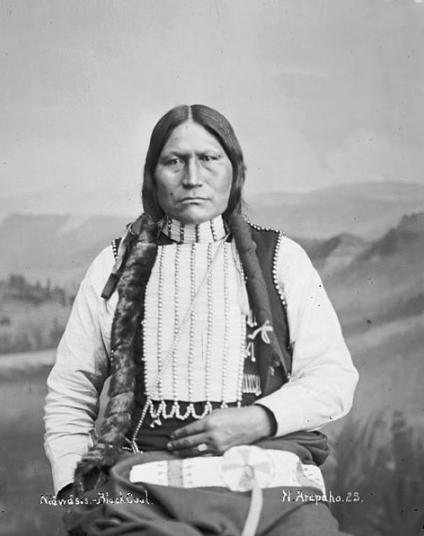
ARAPAHOE, Wyo. (AP) — The approximately 250 tribal and community members hadn’t simply come on a Saturday to enjoy a free feast and listen to tribal leaders speak: They wanted to see what sat behind a three-walled barrier.
Behind the walls sat an elegant and well-aged headdress made of dozens of eagle feathers that streamed down about four feet, a yellow-orange and red cloth and a beaded headband that once belonged to one of the Northern Arapaho’s greatest leaders.
The headdress, belonging to revered Chief Black Coal, was home in front of its people for the first time in more than 130 years after a non-Indigenous man from Massachusetts gave it back to the tribe. It had been in his family’s possession since Black Coal gave it to the man’s great-grandfather. Chief Black Coal’s headdress was revealed for tribal members over the weekend during a repatriation ceremony and feast.
“Chief Black Coal was one of the last true chiefs of the Arapaho Tribe in the 1800s, so this is a great honor to be able to bring this home to our Arapaho people,” Business Council Chairman Lee Spoonhunter said. “We truly believe that the spirit of Black Coal reached out and called to bring this home.”
The repatriation of the headdress was celebrated as a victory for the tribe and cultural preservation, with officials from the tribe’s historic preservation office calling it an example of a relatively smooth exchange in a process they say can be full of challenges. They also say they hope the headdress can help teach tribal members, especially younger ones, about their identity and how to act like a leader.
“I feel like he’s coming back to teach us some things,” Jordan Dresser, collections manager of the Northern Arapaho Tribal Historic Preservation Office, said in an interview before the ceremony. “When you see the headdress, it’s really powerful. … You feel like he’s looking at you and seeing what kind of man or woman you are. And it’s tough, because you have to think about yourself, think about what kind of person you are and what kind of leader you want to be.”

Chief Black Coal led the Northern Arapaho in the 19th century at a pivotal time when the Arapaho and other Indigenous nations in the region were forced to transition to a different lifestyle as U.S. settlers encroached westward. Black Coal is considered — along with the likes of Sharp Nose, Chief Friday, Chief Goes In Lodge and Chief Yellowcalf — to be one of the tribe’s most important and respected leaders in its history.
Temple Smith, the man who previously possessed the headdress, contacted the tribe to return it. His great-grandfather, a dentist who lived in Buffalo, would travel to the reservation to do dental work. That’s where one of his patients — Black Coal — once gave him his headdress.
Sam Dresser, a Business Council member, said he believes the return would please Black Coal and that it makes him happy to know that Black Coal is back among the Northern Arapaho and their traditions — drumming and singing that greeted the headdress on Saturday.
“It’s been more than 100 years since he’s heard that,” he said at Saturday’s ceremony.
The return of Black Coal’s headdress follows other events in recent years that tribal members and those with the Tribal Historic Preservation Office call victories for tribal rights and cultural preservation — repatriation victories that often don’t come easily.
In 2017, the tribe buried three boys who died in the late 1800s far from their families at the Carlisle Indian boarding school in Pennsylvania. Remains for only two of the boys could be found to be returned and buried on Wind River.
More recently, in October, the tribe started its own herd of 10 buffalo, joining the more than 30 culturally important ungulates that live on the reservation as part of the Eastern Shoshone Tribe’s herd.
Repatriating Black Coal’s headdress was — since the man who had it in his possession reached out to the tribe and said he wanted to give it back — relatively simple. Repatriating artifacts can often be much more challenging, historic preservation officials and experts say.
Tribes have several mechanisms when it comes to repatriation. The federal Native American Graves Protection and Repatriation Act of 1990 required institutions receiving federal funding, like universities and museums, to document any artifacts they have that could possess cultural significance to Indigenous people and tribes. The act also offered a process tribes could use to repatriate those items.
But it doesn’t apply to private collectors or items found on private property. And there’s still much legislation that could be enacted to improve the ways Indigenous people and tribes can seek the return of their items, said Shannon Keller O’Loughlin, executive director and attorney at the Association on American Indian Affairs, which focuses much of its work on repatriation.
In many cases, she said, artifacts held by museums and other institutions were stolen, taken from gravesites or looted at cultural sites and trafficked by collectors. In some cases, Keller O’Loughlin said her organization will have to negotiate with those who have artifacts and sometimes threaten litigation.
Although most institutions and museums have become supportive of tribes seeking to repatriate their artifacts since the act passed, Keller O’Loughlin said some are still hesitant to work with tribes or intentionally stall when they seek return of their items.
“It’s been a changing landscape,” she said. “… What ended up happening though, through the repatriation process over the last three decades, this relationship between tribes and institutions have been built, where institutions finally understand what they’ve had in their collections all this time, and have been able to build relationships where they can tell a better story.
“There’s still plenty of holdouts and what’s disconcerting about that is those holdouts are usually the older or well-endowed institutions.”
Despite the challenges, Keller O’Loughlin said repatriating artifacts can have a powerful effect for tribes.
“Repatriation is a process of kind of walking backwards so that we can walk forward. We have to look back and resolve injuries of the past so that we can move forward,” she said. “Our communities have suffered intergenerational and historic trauma for a few centuries now. And one of the ways we can start healing from that is returning our ancestors, returning our ceremonial and cultural patrimony home so we can lay things to rest and rebuild our cultures in freedom.”
The work, Dresser said, is difficult and emotional. Sometimes, he added, institutions question whether tribes have the expertise to properly take care of the items they want back or question whether those items are connected to the tribe.
“People don’t realize repatriations are a lot of work,” Dresser said. “The initial talks of it to actually getting the items … it’s a lot of work; it’s a lot of paperwork, but it’s also a lot of emotional work.”
Jordan Dresser and other Tribal Historic Preservation Office officials said they hope the headdress can soon be displayed in the Northern Arapaho Experience room at the Wind River Hotel and Casino after preservation and restoration work is completed.
Eventually, he said, he hopes it can be a prominent piece of a museum celebrating the Northern Arapaho, adding that he hopes the headdress repatriation’s momentum can be sustained to establish that museum.
“We’re gonna do it,” Dresser continued. “I just want to do it now. … It’s an exciting time.”
In the meantime, Dresser said his office will continue to try to repatriate more Northern Arapaho artifacts. He said his office is already in discussions to bring back four Arapaho skulls that a Chicago museum currently possesses.
A museum, Dresser said, would be especially powerful for those who are struggling to learn about themselves and their culture, or for children to come and learn about past Arapaho leaders and to demonstrate that they can be leaders today.
“Museums are very powerful for multiple reasons, because they are a site where people make meaningful connections with themselves,” he said. “I just want it to be that. I just want us to have a museum that can do that, where you can come and you can learn about yourself in a safe space.”
________
By Chris Aadland, Casper Star-Tribune
Copyright 2020 The Associated Press. All rights reserved. This material may not be published, broadcast, rewritten or redistributed.


